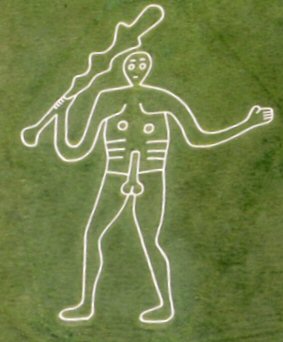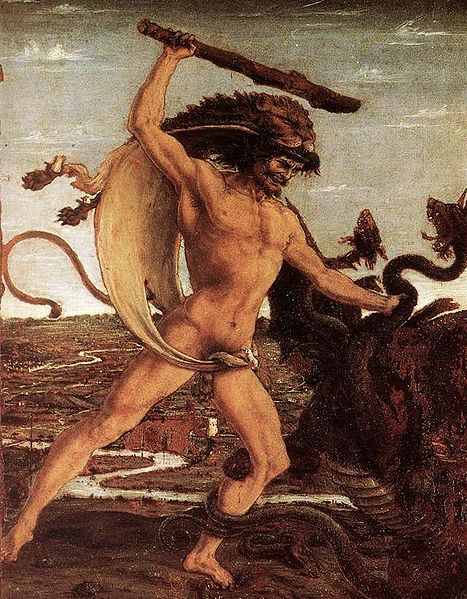|
Location:
Cerne Abbas Village,
Dorset (ST
667017) |
Grid Reference:
50.8� N, 2.48� W. |

 Cerne Abbas:
(Chalk-cut Figure).
Cerne Abbas:
(Chalk-cut Figure).
This huge and
impressive giant figure is formed by a trench 0.3m (1ft) wide and the same
depth, cut into the underlying chalk. He is 55m (180ft) long and 51m (167ft)
wide, and his right hand holds an enormous knobbed club 36.5m (120ft) long.
His most famous and prominent feature is the erect phallus and testicles
which indicate that fertility rites were practised here. This is supported
by the fact that until recently, on 1 May maypole dancing and other
celebration were held in the Iron-Age earth enclosure known as the Frying Pan
situated a little further up the hill, above the giant's left arm.
It has been suggested that
his large erection is, in fact, the result of merging a circle representing
his navel with a smaller penis during a Victorian re-cut
(2)
|
Cerne Abbas Giant:
('Rude Man', 'Rude
Giant') |
The first reference to this figure dates back to 1694: a payment in the Cerne Abbas churchwarden's accounts of 3 shillings towards the re-cutting of
the giant. The first written reference is by John Hutchins in his Guide
to Dorset, 1751, but no one knows exactly when or who first cut the
Giant. Recently, the historian Ronald Hutton stated that it was cut in the
17th century by the Lord Holles' servants. In fact, it's unusual that,
unlike the Uffington White Horse, there is no reference to the Cerne Abbas
Giant in Medieval documents. During the Civil War (1644 - 1660), Lord Holles
was Lord of the Manor but his estate was sequestered and mismanaged by his
steward. Maybe then his servants, in this period of chaos, cut the giant in
the hillside.
A local legend says that a real giant was killed on the hill and that
the people from Cerne Abbas drew round the figure and marked him out on the
hillside. Barren women were said to conceive soon after sleeping on the
Giant's body, while young women wishing to keep their lovers faithful would
walk around the figure three times. Another story ascribes the figure to the
monks from the nearby abbey, who cut it as a joke against their abbot. The
figure is kept free from grass by a scouring every seven years.
In
2008, a group of archaeologists using special equipment
found that part of the carving had been allowed to be
obliterated. (1)
According to these findings, the free arm should have
held a depiction of an animal's skin, giving credence to
the theory that the giant was a depiction of a hunter,
or alternatively, Heracles with the skin of the Nemean
lion over his arm.
Who Does it Represent:
The giant is generally considered to represent the god Helith or
Hercules, and recent surveys suggest that the figure was cut at the end of the
second century AD when the Emperor Commodus (who believed he was a
reincarnation of Hercules) revived the worship of this god.
If the
Cerne Giant is of any great age, then he probably
represents an ancient god; one suggestion is he could be
the Celtic god Nodens, who was
worshipped by the Durotrige tribe who lived in Dorset
before the arrival of the Romans in AD 43. The support
for this idea comes from a bronze handle, found when
land on a Celtic fort site near Blandford Forum was
ploughed up. Archaeologists decided that the handle was
Celtic, and that the figure of a naked man depicted on
it was Nodens; the Giant on the hill at Cerne Abbas
shows a marked relationship in the style of drawing.
(1)
Another
contender is the Roman god Hercules. In 1764
William Stukely wrote that people in the area called the
Giant "Helis". Another writer stated that up until the
6th century, the god Helis was worshipped. Helith and
Helis may be bastardisations of the ancient version of
the name for Hercules - Hetethkin. The Giant can also be
compared with representations of Hercules found in other
parts of the country, indicating that the figure dates
from the 2nd century at the latest.
Another
story says the giant came from Denmark leading an
invasion of the coast, and was beheaded by the people of
Cerne Abbas while he slept on the hillside.
(3).
Article: The Independent. 1994.
(Cerne Abbas giant may have held severed head).
THE
CERNE ABBAS giant, a naked relic of ancient British
heritage, may once have worn a cloak over his shoulder and
carried a severed head in his left hand. New studies of the
soil around the giant have found disturbances which suggest
that the figure has changed considerably since it was cut
into the chalk of a Dorset hillside about 2,000 years ago.
The
lines could represent a cloak or animal skin which was a
common feature of figures that have survived from this
period. It is known from Roman sources that the ancient
Britons generally went into battle naked. This is probably
because they normally wore only a blanket, carried over the
shoulder like the Scots' plaid, and this would encumber them
in battle.
Evidence of soil disturbance
suggests that the figure may have had additional features
which have been lost. A small knoll, some 40cms high, under
the left hand could once have been a representation of a
severed head.
A severed head would fit with
an Iron Age god, a guardian of the tribe returning from
battle with the head of an enemy. The figure is in the
centre of territory once occupied by a tribe called the
Durotriges, an area which is roughly equivalent to present
day Dorset. There is an ancient holy well near by. The Celts
were keen on sacred springs and so it is an obvious place to
create an image of a guardian God.
There are many examples from
the Romano-British period of naked warriors carrying a club
and a severed head, including a coin minted in the days of
King Cymbeline.
The studies have not only
raised new questions about the giant, they have also settled
some old controversies. During Victorian times the giant's
penis became discreetly veiled by the natural growth of
shrubbery. Scholars believe that when the penis was
subsequently re-excavated it was extended by some two and a
half metres. This has now been confirmed.
(Link
to Full Article)
Article: The Telegraph. 2010.
(Cerne Abbas Still working on
local Fertility Rates)
'Since
Victorian times, the 180ft
Cerne Abbas Giant in Dorset
has been said to cure
childlessness and bless
women with improved
fertility. Now the women in
the surrounding towns and
villages have the highest
birth rates in the country.
The latest figures from the Office of
National Statistics show that the women of North Dorset have
on average three children each � nearly double the national
average and nearly three times as much as the city dwellers
of Westminster'.

Herculese
and the Hydra by Antonio Pollaiuolo, 1432 - 1498
(Other
Prehistoric English Sites)
|

